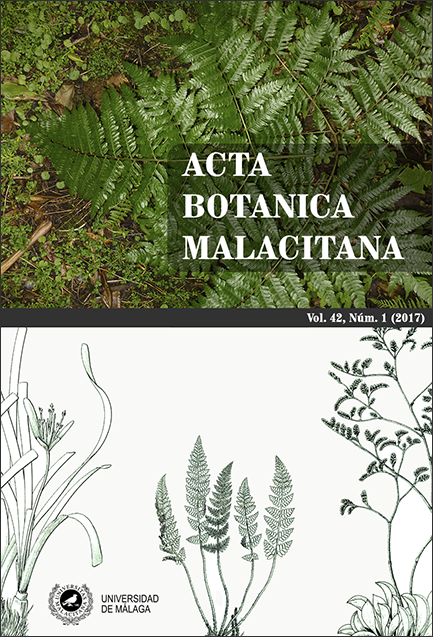Novedades en Pteris L. (Pteridaceae) para Costa Rica.
DOI:
https://doi.org/10.24310/abm.v42i1.2384Abstract
Dos especies de Pteris L. para Costa Rica se describen aquí. Pteris arbelaezia- na A. Rojas que difiere de P. muricatopedata A. Arbeláez porque tiene escamas del rizoma y estípite más largas, hoja pinnada y distribuido a elevaciones superiores. Pteris caridadae Testo & J. E. Watkins difiere de Pteris livida Mett. por sus escamas del rizoma y estípite más estrechas, las escamas del estípite densamente cubriéndolo todo, pinnas basales bifurcadas con la pinna basis- cópica más pequeña y pinna apical más corta en relación con las laterales.
Downloads
Metrics
References
Arbeláez, A.L. (1995). Two new species and new records for Pteris (Pteridaceae) from Colombia. Brittonia, 47(2), 175–181.
Arbeláez, A.L. (1996). Monografía N°18. La Tribu Pteridaceae. In: Flora de Colombia, P. Pinto (Ed.). Universidad Nacional de Colombia. Bogotá. p. 10–105.
Gómez, L.D. & Arbeláez, A.L. (2009). Flora de Nicaragua. Missouri Botanical Garden Press. P. 134–137.
Lellinger, D.B. (1989). The ferns and fern-allies from Costa Rica, Panamá, and The Chocó. Part I. Psilotaceae through Dicksoniaceae. Pteridología, 2A, 1–364.
Lellinger, D.B. (1997). Pteris deflexa and its Allies. Amer. Fern J., 87, 66–70.
Mickel, J.T. & Beitel, J.M. (1988). Pteridophyte Flora of Oaxaca, Mexico. Mem. New York Bot. Gard., 46, 320–327.
Mickel, J.T. & Smith, A.R. 2004). The Pteridophytes of México. Mem. New York Bot. Gard., 88, 533–544.
Moran, R.C. (1995). Pteris L. In Flora Mesoamericana, R.C. Moran and R. Riba (Eds.). Volumen 1. Psilotaceae a Salviniaceae. Universidad Nacional Autónoma de México. México D.F. p. 140–144.
Moran, R.C. (2012). Neotropical Genera of Ferns and Lycophytes. Organization for Tropical Studies. San José, Costa Rica. Mimeografiado. 407 p.
Murillo, M.T., Murillo, V. & León, V. (2008). Los Pteridófitos de Colombia. Arfo. Bogotá, DC. 533p.
Prado, J. & A.R. Smith, A.R. (2002). Novelties in Pteridaceae from South America. Amer. Fern J., 92, 105–111.
Prado, J. & Windisch, P.G. (2000). The genus Pteris L. (Pteridaceae) in Brazil. Boletim do Instituto de Botánica 13, 103–199.
Rojas, A.F. & Chaves, J.M. (2014). New records of Pteris (Pteridaceae) from the Neotropics. Rev. Mex. Biodivers. 85, 301–303.
Rojas, A.F. & Palacios, M. (2006). Una especie nueva de helecho del género Pteris (Pteridaceae) endémica de Costa Rica. Rev. Biol. Trop. 54(3), 1061–1066.
Schuettpelz, E. & Pryer, K.M. (2007). Ferns phylogeny inferred from 400 leptosporangiatae species and three plastid genes. Taxon 56(4), 1037–1050.
Smith, A.R. (1981). Pteridophytes, p. 1–370. In: D.E. Breedlove (Ed.). Flora of Chiapas. Part 2. Calif. Acad. Sci., San Francisco, California, EEUU.
Smith, A.R. (1995). Pteridophytes, p. 1–334. In: P.E. Berry, B.K. Holst & K. Yatskievych (Eds.). Flora of the Venezuelan Guayana. Volume 2. Pteridophytes, Spermatophytes, Acanthaceae-Araceae. Timber, Oregón, EEUU.
Smith, A.R., Pryer, K.M. Schuettplz, E., Korall, P. Schneider, H. & Wolf, P.G. (2006). A classification for extant fern. Taxon 55, 705–731.
Stolze, R.G. (1981). Ferns and fern allies of Guatemala. Part II. Polypodiaceae. Fieldiana Bot., n.s. 6, 446–458.
Tryon, R.M. & Stolze, R.G. (1989). Pteridophyta of Perú. Part II. 13. Pteridaceae-15. Dennstadtiaceae. Fieldiana Bot., n.s. 22, 70–81.
Zhang, L., Rothfels, C.J. , Ebihara, A., Schuettpelz, E., Le Pechon, T., Kamau, P., He, H., Zhou, X.M., J. Prado, A. Field, G. Yatskievych, X.F. Gao & Zhang, L.B. (2014). A global plastid phylogeny of the brake fern genus Pteris (Pteridaceae) and related genera in the Pteridoideae. Cladistics (2014), 1–18.
Downloads
Published
How to Cite
Issue
Section
License
All information related to the licensing of published works in Acta Botanica Malacitana and copyright can be found in our Editorial Policy.







1.png)
